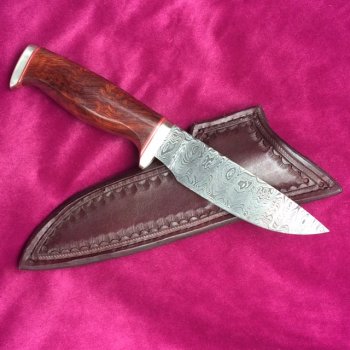First time outta the gate, and if it's by hand, I'd recommend cleaning the mill scale. A slight scarf on each piece is helpful too. One "trick" that I have discovered over the years is that IF you grind anything that's going to be stacked/forge welded, whether with belt or angle grinder, make the scratch lines run across the pieces.....this works like "capillary action" to drive out flux..... if you have scratches running lengthwise on the pieces, flux inclusions are much more likely.
There is also a significant difference depending on the "flux" you choose. Run of the mill 20 mule team borax has a high moisture content, and will "boil" and fall off before it has a chance to melt. Anhydrous borax is my flux of choice..... it's a much more pure version of borax, with the moisture removed, It melts and looks like a thick coating of honey on a hot billet, and doesn't "boil off". Because it stays there, it's a much better cleaner/Oxygen barrier then regular 20 mule team.
I'm assuming it's by hand, so I'd recommend starting with a simple stack of maybe 10-12 layers, in a single altered stack (1 piece 1084, 1 piece of 15N20, and so on). If you have a stick or MIG welder, clamp the stack tightly and weld across the edges in 3 even spaced places on each side. LEAVE THE ENDS OPEN..... a big mistake most beginners make is to weld the ends....this prevents flux from escaping that way, and often causes flux inclusions. Also, you have to remember that if you only stick or MIG weld the ends, or ends of the edge, the steel will expand when heated, and the middle will bow out, making it nearly impossible to weld/work with.
Weld a "handle" on one end..... it's tough enough to weld successfully the first time, don't handicap yourself by having to use tongs. When you weld, start from the end nearest you, and work your way to the other end...... that way you don't spray yourself with hot flux.
If you don't have the ability to stick or MIG, and intend on using "wire"....that's a tough one too......wire is no different then the steel itself..... you can wrap/twist it tightly before you heat the billet, but when heated, the wire will expand too, and can be a difficult mess to deal with.
When it comes to heating the billet, heat it to a orange to bright orange before applying flux. Apply flux when the billet it too cold, only waste flux, and doesn't get it between the layers were it can do it's job.
Personally, I don't even place a damascus billets into the forge, until the forge is at 2350F. My philosophy is that I can refine grain growth through thermal cycling, but if I have welds that were too cold, all I have is a "glue job", that WILL cause me grief.....and be very difficult to repair. I tend to work most damascus billets at welding heat, just for the reason I mentioned.
Good luck! Let us know how it goes!


